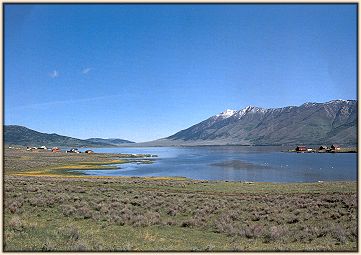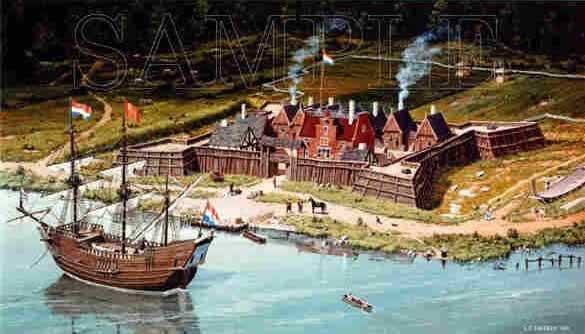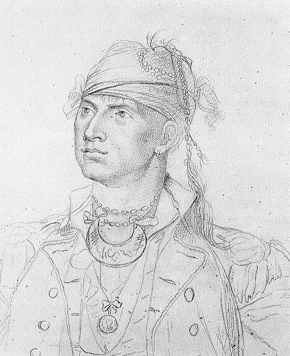|
|
Canku Ota |
|
|
(Many Paths) |
||
|
An Online Newsletter Celebrating Native America |
||
|
August 24, 2002 - Issue 68 |
||
|
|
||
|
This Date In |
||
|
North American Indian History |
||
|
from On This Date in North American Indian History at http://americanindian.net |
||
| August 24, 1835: | The United States signs a treaty (7 Stat., 474.) with the Choctaw, Comanche, Creek (Muscogee), Cherokee, Osage, Quapaw, Seneca and Witchita at Camp Holmes "on the eastern border of the Grand Prairie, near the Canadian River." Governor Montfort Stokes, Brigadier- General M. Arbuckle, represent the U. S. Many Indians sign the treaty. |
|
|
|
| August 25, 1737: | A agreement ise signed by Thomas Penn and Munsee Chiefs Manawkyhickon and Nutimus. Teeshacomin and Lappawinzoe also sign. The agreement recognizes an old deed made in 1686. The agreement calls for Indian lands to be sold along the Delaware River for the distance that a man can walk in a day and a half. This is called the "Walking Purchase" and is performed on September 19, 1737. |
|
|
|
| August 26, 1842: | The Caddoes sign a treaty in Texas. They agree to visit other tribes and try to convince them to also sign treaties with Texas. |
|
|
|

Henry's Lake, Idaho |
|
| August 27, 1878: | Captain James Egan, and Troop K, Second Cavalry, are following a group of Bannocks, who have been stealing livestock along the Madison River. Near Henry's Lake, Captain Egan's forces skirmish with the Bannocks, and recover fifty-six head of livestock. The escaping Bannocks are starting to follow the trail taken by the Nez Perce, last year. |
|
|
|
| August 28, 1565: | Leading an expedition of 1,500 soldiers and colonists, Pedro Menendez de Aviles lands on the coast of Florida. His mission is to defeat the Protestants in the area, and to claim the land for Spain. Next month he establishes the town of St. Augustine. |
|
|
|
| August 29, 1978: | The Area Director, Minneapolis Area Office, Bureau of Indian Affairs, has authorized an election for amendments to the Constitution and By-Laws of the Lac Courte Oreilles Band of Lake Superior Chippewa Indians of Wisconsin. The election will be held on December 15, 1978. |
|
|
|
 Fort Orange ©1986 L.F. Tantillo & M.B. Picotte |
|
| August 30, 1645: |
A peace treaty between the Dutch, led by Willem Kieft, and several local tribes is signed at Fort Orange, in modern Albany. This treaty concludes a protracted conflict in the area. |
|
|
|
| August 31, 1715: | After a history of occasional skirmishes, at the urging of Europeans living in Pennsylvania, the Conestogas and the Catawba tribes agree to sign a peace treaty. They agree to stop fighting among themselves. |
|
|
|
| Sept. 1, 1739: |
Several Shawnee Chiefs sign a peace treaty with British Pennsylvania authorities not to become allies with any other country. The British agree to enforce previous treaties banning the sale of rum to the Indians. |
|
|
|
| Sept. 2, 1792: | Mohegan Samson Occom dies in New Stockbridge, New York. A protégé of Rev. Eleazar Wheelock, Occom learns numerous foreign languages, become an ordained minister, be the first Indian to preach in England, minister to many Indian tribes, and be instrumental in the establishment of Dartmouth College in New Hampshire. |
|
|
|
| Sept. 3, 1761: | According to some records, a conference regarding land questions and the return of prisoners is held for the next ten days between representatives of the British in Pennsylvania and the Cayuga, Conoy, Delaware, Mahican, Nanticoke, Oneida and Onondaga Indians. |
|
|
|

The Far Off Warrior also called the Bird Tail King, after a sketch by Trumball in 1790. Hawkins refers to him by several different names; Tustunnuggee Hopoie, meaning Far Off Warrior; Micco Thlucco, meaning Little Prince, and also Bird Tail King. |
|
| Sept. 4, 1813: | 500 warriors of the White Stick faction of the Creeks gather in Coweta, across the river in Alabama from modern Columbus Georgia. With 200 Cherokee warriors, they make plans to attack a band of Red Stick Creeks, followers of Tecumseh, over 2,500 strong. The White Sticks are led by Tustunnuggee Thlucco and Tustunnuggee Hopoie. |
|
|
|
| Sept. 5, 1570: | A Spanish colony expedition in sailing up the Chesapeake in Virginia, when they reach the area they will call Axaca somewhere near the Rappahannock. The local Indians will force the Spanish to abandon the effort. |
|
|
|
| Sept. 6, 1676: | Weetamoo is the Sachem of the Wampanoag town of Pocasset, Rhode Island. The sister-in-law of King Philip, she leads as many as 300 warriors in battle. While trying to escape from European soldiers from Taunton, Massachusetts, she drowns in the Taunton River. Her head is cut off, and displayed on a pole in the town. |
|
|
|
|
For Information on This Date in Canada visit our friends at: |
|
Canadian
Aboriginal News |
|
|
||
|
|
||
| Canku Ota is a free Newsletter celebrating Native America, its traditions and accomplishments . We do not provide subscriber or visitor names to anyone. Some articles presented in Canku Ota may contain copyright material. We have received appropriate permissions for republishing any articles. Material appearing here is distributed without profit or monetary gain to those who have expressed an interest. This is in accordance with Title 17 U.S.C. section 107. | ||
|
Canku Ota is a copyright © 2000, 2001, 2002 of Vicki Lockard and Paul Barry. |
||
|
|
|
|
|
The "Canku Ota - A Newsletter Celebrating Native America" web site and its design is the |
||
|
Copyright © 1999, 2000, 2001, 2002 of Paul C. Barry. |
||
|
All Rights Reserved. |
||
